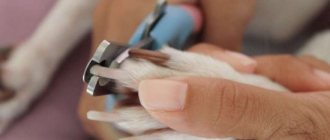- home
- Reproduction
15.04.2018
In their natural habitat, animals give birth from late spring to early autumn. Reproduction of hamsters at home depends on the owner of the rodents, since animal owners prefer to keep rodents in separate houses. Living in the same cage, rodents conflict, fight and reproduce uncontrollably. Let's look at the main questions about mating in hamsters: when rodents reach sexual maturity, when and under what conditions to mate, how to determine pregnancy, what to do if animals do not mate.
How to breed hamsters. Preparing the female and male.
- The first thing to remember is that future parents should always live separately from each other. Otherwise, it could be fatal for one or both animals. Same-sex hamsters will also not get along together.
- If you are going to breed small hamsters, do not mix up the breeds. The Djungarian breed and the Campbell's hamster are very similar to each other, but serious problems may arise during crossing, and you may lose the female.
- It is important to provide hamsters with proper nutrition throughout their hamster life. If you feed, especially a female, just anything, this can lead to non-viable offspring, or she will eat them after birth. During pregnancy and nursing hamsters, the female needs to be given protein food more often, about every other day.
- Now separately about the females. They reach sexual maturity at two months, but this is too early an age for mating, since the body is not fully formed. Ideal age is 4 months. But you shouldn’t wait until six months. At the age of 12-13 months, females lose their ability to reproduce.
- In order to prevent wear and tear on the female’s body and get healthy offspring, it is necessary to observe pauses between matings of three months. It turns out that from one hamster you can get offspring three, maximum 4 times.
- Males. It's a little easier with them. They reach sexual maturity at 5 weeks and until the end of their lives. It is recommended not to breed the male too often so that the hamster does not lose its fertility.
Some aspects of mating
To prevent unwanted mating of hamsters, it is recommended to keep animals of opposite sexes separately. The female is placed with the male only for reproduction. This measure helps to avoid unwanted pregnancy and fights.
Hamsters begin to breed from 3 to 6 weeks of age. Djungarians can breed from an earlier age.
Reproduction at an early age adversely affects the health of the mother and offspring. The age of the female from 3 months to six months is the most favorable for mating. The male can actively reproduce for up to one and a half years.
It is recommended to allow the female to “rest” after giving birth for at least three months. During this time, she will regain strength and prepare for a new pregnancy. It is recommended to mate the female again at the age of 8–10 months. At 12–14 months of life, some individuals lose the ability to reproduce.
Males breed from 15 weeks of life. Most often, males are fertile throughout their lives and are sensitive to the choice of a partner. Frequent mating negatively affects the health of the male. He may lose his ability to reproduce.
Stages of breeding hamsters at home.
Detection of estrus in a female. Every 4-5 females come into heat and last about a day. Signs include a characteristic musky odor and arching of the back when you stroke the hamster's back. Only during this period will the female allow the male to approach her. If mating did not occur during the meeting, and the hamsters began to fight, then there is no estrus.
- It is better for hamsters to arrange a date on neutral territory, or, in extreme cases, on the territory of the male. Mating lasts about 20 minutes. It is important to supervise hamsters to avoid fights. When a couple loses interest in each other, you can safely seat them.
- Next, you need to monitor the female for 4-5 days for the onset of estrus. If it occurs, there is no pregnancy.
- The pregnancy of Syrian hamsters lasts 17-20 days, in small breeds it lasts 24-30 days. Already a week after mating, it is better to stop picking up the female and give her more filler for the future nest (no newspapers or hard sawdust). It happens that after the expected period there are no offspring. There may be several reasons. This could be a false pregnancy, when the signs are visible, but the offspring are not formed. As a rule, after this the female returns to normal and is ready for mating again. A more serious reason is stress or a threat to life during pregnancy. Then the fetus can dissolve.
- After the birth of the cubs, there is no need to disturb them and the female for up to three weeks. At the age of 24-28 days, hamsters should be separated by gender to avoid pregnancy of girls and mothers. After another week, place all the hamsters one by one. If you have Robovsky hamsters, you can keep two sisters together, provided there are no fights between them.
There is no need to breed hamsters and other rodents just like that. Both females and males will live just fine without breeding for their entire hamster life. The absence of cubs will not harm them in any way. Estrus in females is usually painless.
Does false pregnancy occur in hamsters?
How to determine pregnancy in general? After mating, estrus does not occur, the hamster's mammary glands swell, and the animal changes behavior. But, surprisingly, these signs are also inherent in the so-called false pregnancy, which can occur in Syrian hamsters and dzungarians.
It is quite simple to understand that a hamster’s pregnancy is false. Childbirth simply will not occur, and after 2-3 weeks the animal will return to its normal life. Typically, the cause of the development of such a pathology is stress, under the influence of which the embryos are rejected by the mother’s body. If several matings result in a false pregnancy, then the problem is in the animal’s body. Only an experienced veterinary doctor can solve it.
Features of reproduction
Among the people, hamsters are known as very prolific animals, although this is only partly true. In captivity, hamsters actually breed all year round, but in the wild they obey instincts and reproduce only in the spring and summer. On average, a female gives birth 2–4 times per year, and the number of cubs in a litter varies greatly - from 1 to 18, but on average 8 animals are born in a litter.
How do hamsters give birth?
Not every owner is able to witness the birth of their animal, since in most cases the birth of offspring occurs at night. Despite this, it is worth knowing the features and signs of the appearance of babies, as well as possible complications in the female and the procedure for action in such a situation.
Sure signs of approaching labor and its course
You can find out that your pregnancy is about to end by the following signs:
What to do, how to help a hamster give birth
As such, human assistance is not required when giving birth to a hamster. The main task is to provide comfortable conditions for the expectant mother:
- 1-3 days before giving birth, you need to clean and wash the cage (it is better to use a one-story one for a pregnant female), replace the filler, and supply food that does not spoil.
- It is necessary to maintain an optimal temperature (21–24 °C) in the room and avoid drafts.
- It is advisable to place the cage with the expectant mother in a secluded, quiet, cozy place where nothing will disturb her.
- A pregnant or lactating female should not be frightened, picked up or touched again.
- It is strictly forbidden to keep a male and a female in the same cage, and not only during pregnancy and lactation, but at any time at all! Animals of different sexes should be placed in different cages immediately after mating.
These are the main manipulations that you need to carry out before giving birth. If a female gives birth during the day in your presence, you can simply observe. However, if there are a lot of offspring and the female cannot cope, you can try to provide help: carefully wrap some of the babies in a paper napkin to remove mucus and amniotic sac, then cut the umbilical cord a little above the belly and return them back to the cage with the rest of the babies.
Under no circumstances should you interfere with the process if the female begins to eat the offspring after giving birth. The maximum that can be done in this situation is to provide her with protein food. Usually, after resting, the female begins to let the animals approach her nipples. If this does not happen, the cage should be placed in a dark place, covered, and, perhaps, within a short time the mother will begin to care for the offspring.
Possible complications
Complications can occur both during childbirth and after the birth of offspring:
- Toxicosis . Occurs in the last days before giving birth; the female and her brood may die during childbirth or shortly after. There is no therapy for this condition.
- Death of offspring in the womb. Occurs due to poor nutrition, infections, age, physiological characteristics or genetics. If surgery to remove the uterus is not performed, the female will soon die from blood poisoning.
- Prolonged labor. They arise due to age over 12 months (in females, over time, the pelvic bones lose elasticity), due to the large size of the cubs, especially if there are few of them in the brood. In this case, unproductive contractions occur - the fetus does not pass through the pelvic bones even with strong and numerous contractions. In this case, surgery is necessary.
- Mastitis . Disease of the mammary glands occurs soon after childbirth and leads to lack of lactation and inflammation.
- Endometritis. Inflammation of the uterus also occurs soon after childbirth, manifested by bloody, unpleasant-smelling discharge that lasts more than 3 days.
Why don't hamsters reproduce?
Hamsters reproduce only under favorable conditions. There are several reasons for the absence of offspring in animals:
- Rodents of the same sex.
Quite often in stores they misidentify gender or speak at random. This leads to attempts to reproduce individuals of the same sex. Before mating, make sure there is a boy and a girl in the box.
- Excess weight.
Obesity in females is especially common among Djungarians and negatively affects the production of hormones. This prevents pregnancy. It is easy to determine the obesity of miniature pets: when walking, the tummy of a fat animal touches the floor; when a Homa sits, its paws are hidden in folds of fatty tissue.
To prevent obesity, monitor your pet's diet, do not allow him to eat too much and do not give high-calorie foods often.
- Poor nutrition.
An insufficiently varied diet and lack of vitamins negatively affect reproductive abilities. Malnutrition also leads to a lack of vitality. The pet may not have enough energy for the mating process and further pregnancy. This problem can also cause cannibalism in females. Djungarians especially often eat their offspring.
- Illness and stress.
Serious diseases weaken the body, the animal is not able to reproduce for some time. Constant stress also affects the appearance of offspring. When hamsters begin to mate, they should not be disturbed by extraneous noise, drafts, or other pets. If something constantly interferes with rodents, it is quite difficult to get offspring.
During the mating period, try to create the most comfortable conditions for your pets. Then the chances of getting young animals will increase.
Caring for your hamster after giving birth
Like any new mother, a hamster needs special care and attention after all the hard work done. The most important thing you must do is to provide her with peace, quiet and good nutrition so that the pet can recover and properly care for the cubs.
Peace and quiet
If, before giving birth, you have properly prepared the place for the cage (a secluded, quiet, shaded corner), you should not change anything, let the relish with the offspring remain there for 2-3 weeks. At this time, you should not disturb your pet, try to pick up the hamsters, or disturb the animals in any way. This may be fraught with the refusal of the female to feed the cubs or even cannibalism. Other pets should not be able to approach the cage and disturb the hamsters.
What to feed
During pregnancy, childbirth and feeding a brood, a hamster loses up to 1/3 of its weight, even if its diet is complete and balanced, because pregnancy for an animal is a rather energy-consuming and depleting process. At the same time, recovery is worse in older pets. Therefore, it is very important to support the female’s body with a balanced, varied diet.
The female may show interest in food already half an hour after the birth of the babies. During prolonged labor, when babies appear at large intervals (not to be confused with protracted, difficult labor!), the hamster can even rest and eat between the appearance of the animals. Feeding during the postpartum period differs from that of non-pregnant animals. Portions should be increased by 100%, protein content should not be lower than 20%, and fat content should not be lower than 10%. Along with grain mixtures, you should definitely include succulent foods from the list of permitted foods in your diet:
- greens (dill, parsley, lettuce, nettle and dandelion leaves)
- vegetables (zucchini, pumpkin, cucumbers and tomatoes, cabbage, etc.);
- fruits and berries (strawberries, raspberries, pears, apples, peaches and apricots, etc.).
How to tell if your hamster is pregnant
It is not so easy to immediately determine and understand that a hamster is in an interesting position, since the belly of expectant mothers increases only in the second half of pregnancy. What does a pregnant hamster look like?
Important! Signs of pregnancy in hamsters are very indirect, and you can understand whether a hamster is pregnant if you do not know exactly when mating occurred only by the changed behavior of the small animal.
At the same time, you need to understand that, like people, hamsters have their own character, disposition and temperament, therefore, at the beginning of pregnancy, females behave differently. Some become calmer and more peaceful, while others, on the contrary, show anxiety and even aggression towards their relatives or owners. A pregnant dwarf may have increased appetite or thirst.
Important! Visible signs of pregnancy in hamsters appear approximately 10 days before birth.
Pregnant female dzhungarika
Approximately in the middle of pregnancy, the female begins to equip a maternity “nest”, dragging improvised material into it. At the same time, the most reliable sign that allows you to understand that a hamster is pregnant is an enlarged, rounded tummy. By the middle of the term, the nipples enlarge and swell. A pregnant jungarik in the last week before giving birth resembles a large pear. A hamster that is carrying babies tries to move carefully, slowly, and spends little time in the play wheel.
Before giving birth, female hamsters set up a maternity “nest” or rebuild their house.
If you are wondering whether your hamster became pregnant after mating, you can do a simple test.
about eight days after mating, examine the female with your hands. Carefully place the animal with its front paws on a flat, hard surface, and clasp its tummy with your hands from behind. The thumbs will be on the back, and the rest will be on the stomach. Feel the tummy from the ribs to the pelvic bones. This way you can feel the fruits, which resemble small balls to the touch, and you will understand that the hamster is pregnant.
A few days before the babies are born, hamsters become very restless, they can rush around the cage, carry various objects and food supplies into the maternity nest. In this case, the hamster can simultaneously prepare several birthing places in the most secluded corners of the cage.
When can you take hamsters away from their mother?
Hamsters are born absolutely helpless: they are blind, deaf, completely hairless and red; for minimal orientation in space and finding the mother, the babies have a slightly developed sense of smell. In general, they are completely dependent on their mother and are very vulnerable - little hamsters will not survive without their mother until they are 10 days old!
Some development features:
- on the 5th day the first fur appears;
- at the age of a week, babies begin to try solid food;
- on the 14th day the eyes begin to open;
- On days 20–21, lactation ends completely and the babies switch to independent feeding.
Thus, the appearance of offspring in hamsters is a rather exciting, but extremely responsible process. You should not allow pets to reproduce at random, because pregnancy and childbirth are a difficult task for females. Therefore, the birth of small hamsters must be approached responsibly, the intervals between pregnancies must be observed, the female must be given the opportunity to fully recover and the most appropriately provided comfortable conditions for the pet so that the life of her and the babies is safe!
How long do hamsters stay pregnant?
The gestation period of representatives of the hamster family is considered the shortest among mammals. Newborn hamsters are born 16-18 days after the start of pregnancy. The number of days of gestation depends on how long the pregnancy lasts in different breeds.
If you are interested in how to know that a female hamster is pregnant, then her belly becomes noticeable at 8-10 days. During this period, the expectant mother is characterized by increased appetite and rapid weight gain. An animal can gain 8-20 grams depending on its size. Also, the weight depends on the number of cubs.
- hang a drinking bowl;
- remove all unnecessary items;
- remove the wheel, which may distract the female from feeding;
- fill the container with large, fresh sawdust.
A pregnant female hamster will begin to build a nest for birth in advance, so it is better not to touch her for the last few days.
How hamsters give birth: actions during and after childbirth
The birth of offspring is an important stage in the life of any pet. Undoubtedly, happy owners of pet hamsters are also concerned about the issues of pregnancy and childbirth of pets. Every owner of a cute pet fluffy needs to carefully prepare - study the question of how hamsters give birth, learn everything about the course of pregnancy, childbirth and postpartum care for the female.
Shared housing with a male
How many times do hamsters give birth per year? Now comes the most interesting part: females are capable of reproducing offspring monthly. That is 12 times a year.
Based on this, the answer to the question of whether it is worth keeping her with a male is negative. The female is ready for fertilization 24 hours after giving birth. And if it happens, nothing good will come of it. The fact is that she will have to not only bear new offspring, but also feed the previous one. This will weaken the female’s body, and she, being exhausted, is able to snack on the current babies. And the father will not disdain to eat the cubs - cases of hamster cannibalism are widely known among breeders and lovers of these animals.
How are hamsters born?
The length of pregnancy depends on what breed your hamster belongs to. On average, hamsters give birth after 16-22 days of gestation. During this difficult time, the female needs to provide maximum peace, comfort and good care.
Childbirth in hamsters begins in a standard way - the pelvis expands and the birth canal opens. After a few more hours, the animal loses activity and loses its appetite. This means that the hamster is giving birth, be prepared to accept offspring.
Hamsters usually give birth late at night or early in the morning. A first-time hamster gives birth to 4–5 babies at a time, and there will be more in subsequent litters.
Childbirth in animals is usually rapid. In the initial stage, the female sits down, bending over during contractions, and helps herself with her teeth, taking the babies out of the birth canal.
The birth of hamsters occurs at regular intervals, with a difference of 5 minutes. The babies are born in the amniotic sac, and then the female tears the membrane with her teeth so that the hamster can begin to breathe. After the birth of each baby, the hamster gnaws the umbilical cord, eats the membrane and carefully licks the baby.
Genera of Syrian hamsters
Syrian hamsters are born with some special features. On average, childbirth without pathology lasts about 3 hours, but if there are any deviations, then 6–8. Usually 6–10 Syrian hamsters are born, but if the litter is larger, some of the babies have a chance to die. The mother does not always have time to care for all the offspring, freeing them from the membranes.
Genera of Djungarian hamsters
The birth of dzhungarikas occurs within two hours. However, if a hamster has given birth to hamsters, it is not time to immediately relax. Birthing in Djungarians occurs in waves, so after 15 minutes new babies will begin to be born.
Peculiarities of cohabitation of a pair of Djungarian hamsters
Despite the fact that you decided to take a pair at once and motivated this by the fact that your hamsters would not be bored, experienced hamster breeders (there are such!) still advise keeping different-sex Djungarian hamsters in different cages and uniting the family only for mating periods. Why? The fact is that the male jungarik and the female jungarik, despite the fact that by chance they are now husband and wife, will still fight for territory, and in the process of such a fight they will have scratches, bites and others injuries. Therefore, in order to avoid such family bloodshed, it is better to keep them separate. Although, as an exception, there are known cases when a male and a female live in perfect harmony and do not conflict over the centimeters of their cage, but this is extremely rare...
But, if you do not give up hope of living together (or you feel sorry for buying another cage), you can place the hamsters together, but at the same time carefully observe their behavior for several days. If there are no conflicts, that’s good; if the dear ones scold, put them in different cages.
It is noteworthy that, as the experience of hamster breeders shows,
Most often in such conflicts and battles for the cage and clarification of the relationship “who is the boss”, the female wins, and the male almost always yields to her.
In order to prevent the development of possible conflict situations, it is also recommended to have a couple at the same time and of the same age. It is not worth adding a new female who is younger than him to a permanent resident of the cage; the rodents may begin to conflict. And finally, a little secret on how to encourage your hamsters to each other and help them develop a warm relationship.
Place the hamsters in one cage and shine a bright lamp light on it. Naturally, your hamsters will not like this behavior and the dwarf hamsters will try to hide from the bright light in the dark. But there is only one dark corner, so they will have to, willy-nilly, but make friends with each other...
What to do when hamsters are born
So what to do, how to help so that the hamster gives birth to healthy babies? By and large, you don’t need to do anything. The process usually occurs naturally.
However, there are exceptions. It happens that small hamsters are born too quickly and there are too many of them in the litter. The female may not have time to help all the newborns; some may suffocate in the amniotic sac. To prevent such a situation, you need to carefully monitor the process and be ready to help at any time.
In an emergency situation, proceed as follows. Gently wrap the newborn in soft cloth and massage his body, removing mucus and amniotic sac. Newborn hamsters require careful handling.
Under no circumstances should you touch babies with bare hands; you must use cloth gloves. In this case, the human smell will not be transferred to the baby. Otherwise, the mother may not accept the newborn into the family, and this is definitely fraught with death for the hamster.
Another possible complication is that the new mother did not gnaw the umbilical cord. You will need to cut the umbilical cord near the tummy yourself using sterilized scissors.
Preparing the cell for birth
If the owner is sure that his pet is expecting an addition, it is necessary to take care in advance about where and how the female will give birth. Maternity hospitals for hamsters have not yet been invented, and the owner will have to organize it himself.
There is nothing complicated about it. All you need is:
- The cage is one-story with a retractable bottom.
- Soft sawdust that will fill the bottom.
- Clean rags - they will serve as a nest for the expectant mother.
- Feeder and drinker. They can be removed from the old cage after washing them thoroughly.
The cage must be cleaned. First you need to treat not only the bottom, but also the top with laundry soap. Then rinse off the soap thoroughly and scald the cage with boiling water. After which it is placed on a towel and allowed to drain. Remaining moisture is removed with paper towels. Wait until the cell is completely dry.
Now it can be installed in a warm place where there are no drafts and no one can disturb the female in labor. A thick layer of sawdust is poured onto the bottom of the cage. Rags for the nest are also placed here. You can put up a wooden house in which the mother will hide from prying eyes.
They put up a feeder and hang up a drinking bowl. Pre-wash them in the same way as the cage.
Complications after childbirth
The main and most common complication after childbirth is cannibalism. Many females may eat part of the brood. This manifests the instinct to preserve a healthy family. It is recommended not to disturb the hamster for two weeks. Practice shows that young females under the age of two months are susceptible to cannibalism, since their maternal instinct is not sufficiently developed. Such deviations can also be caused by poor ventilation of the nest and severe fright of the hamster.
Another common complication is the female’s refusal to breastfeed her children. Typically, this behavior occurs in females giving birth for the first time, because they are not yet accustomed to the new condition. In this situation, you should do the following: place the mother and the babies in a separate box, from where she cannot escape. After half an hour, the female will begin to take care of the babies.
Often after giving birth, hamsters' coat quality decreases. Symmetrical bald spots appear on the sacrum, and small wounds appear on the skin. Such damage, when treated with disinfectant solutions, heals in 1–2 weeks.
Occasionally, during lactation, females' nipples may become inflamed. It is recommended to treat nipples with a decoction of chamomile, a solution of potassium permanganate, and rub a soothing ointment into the skin.
If all the measures taken do not bring improvement, it is recommended to seek help from a specialist.
Offspring of Djungarian hamsters
As a rule, a female Djungarian hamster gives birth to from 2 to 9 cubs at a time, although there are known cases of heroine mothers who gave birth to as many as 18 small hamsters at once. If the next day after birth you are missing several cubs, most likely the mother hamster simply ate them (animals always do this with weak and sick cubs and you should not interfere in this process).
Small hamsters are born blind and without fur. Their eyes will open only when they are 2 weeks old, and then the first fluff on the body will begin to appear.
It is strictly forbidden to pick up small jungarians! Your desire to admire and touch the cute tiny creatures can end very badly - the mother hamster may simply refuse to feed them and they will die. Therefore, observe - observe, but you should not touch or interfere.
Provide the nursing mother with a good diet and ensure that there is always clean and fresh water in her drinking bowl. And, the female Djungarian hamster herself will do the rest - she will feed and raise her hamsters.
When the hamsters are a month old, they can be considered adults and independent and they no longer need maternal care, therefore, you can safely put them in another cage.
And, finally, it is better to isolate the father of the family from small cubs , since the animal instincts in him will take over, and he can simply eat all his offspring !
Following the life of Djungarian hamsters is quite an interesting activity. However, remember, you can monitor, care, help, but not interfere in any way with the processes that Nature governs. Good luck to you!
Go to the description of feeding Djungarian hamsters.
We are waiting for your feedback and comments, join our VKontakte group!
nutriacultivation.ru
What to feed a newborn hamster
After giving birth, the pet needs to be provided with comfortable conditions. Excessive anxiety can lead to the female refusing to feed her babies. Other family members and children should not have access to the nest with newborns.
The birthing process is quite energy-intensive; the female can lose up to 1/3 of her normal weight. It is recommended to support the hamster's body with a well-chosen, balanced diet. You can feed your postpartum hamster within 30 minutes after birth. During long labor, she can eat even in the intervals between the appearance of babies.
The postpartum diet must be increased by 100%, with the protein content in the diet being at least 20% and fat 10%. The menu is made up of grain mixtures and various additives:
The diet is supplemented with boiled eggs, cottage cheese and chicken meat. Provide the female with constant free access to fresh drinking water.
Tips for creating a diet for a pregnant female
Pregnant females have very different nutritional needs from normal females. Record short periods of fetal development lead to exhaustion of the mother’s body. The diet should consist of high-calorie food, which at the same time is easily digestible, providing the female with useful vitamins and microelements.
Juicy food is a storehouse of benefits for a hamster
Carrots, pumpkin and zucchini are allowed. You need to give your pet a piece of it every day. You can diversify your diet with dill or other dried herbs. Sprouts of wheat and oat seeds are useful. Vegetables should ideally be from your own garden or at least with a minimum content of harmful substances: it is better to buy them at the market rather than in the supermarket. Before serving, any product must be washed and peeled.
Apples and pears should be excluded from the diet.
Protein food is the basis of a pregnant female’s diet
Protein is essential for the hamster to develop normally. Permitted products include:
- boiled rabbit, chicken or beef without salt;
- baby meat puree from beef or turkey;
- quail or chicken boiled egg;
- low-fat dairy products without chemical additives and dyes with a fat content of no more than 1%.
Dry food is a necessary source of energy
This type of product will provide the animal with additional energy, which is vital for bearing fruit. The main requirement is high quality food, and it can be safely given to an animal in unlimited quantities. It is worth remembering that pregnant animals eat almost 3 times more than usual. A double portion will be needed after a week after mating.
Water - what is important to know?
Many people are concerned about their pet drinking too much during pregnancy, but this is a completely normal occurrence. It is necessary to change the water daily and ensure that the hamster always has it available. To improve the vitamin balance, you can add special liquid supplements for pregnant rodents.











